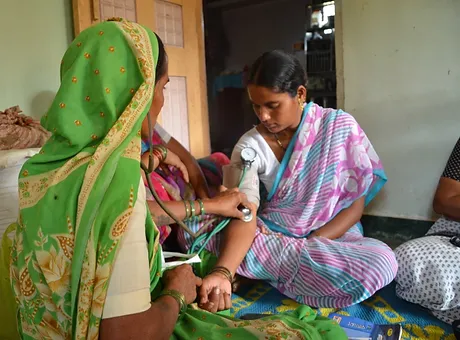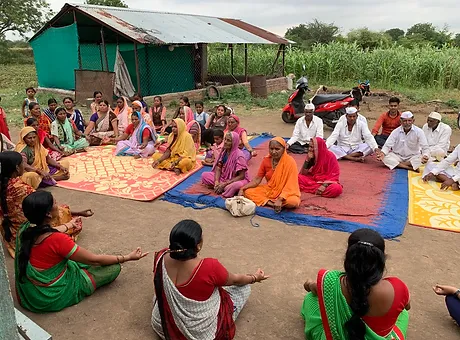The Jamkhed Model’s impact – Infant mortality dropped from 174 to 14-16 per thousand, prenatal coverage rose to 99%, and immunization rates surged to over 95%.
Jamkhed, a drought-prone area in central Maharashtra is surrounded by villages, with the nearest city of Ahmednagar more than an hour away. Poverty, malnutrition, infectious diseases, infant and maternal deaths and occupational injuries were rampant in the 60s and 70s. Healthcare services were absent and the low status of women and caste-based prejudices contributed significantly to the chronic state of ill health of the village communities.
Drs set up the Comprehensive Rural Health Project (CRHP) in Jamkhed. Raj and Mabelle Arole. They had graduated from the Christian Medical College in Vellore and obtained their residency training in medicine and surgery and Master of Public Health degrees as Fulbright Scholars at Johns Hopkins University in the USA.
The Aroles returned to India to establish the CRHP in the 1970s as a comprehensive, community-based primary health care programme, focused on community cooperation and participatory development. Popularly known as the ‘Jamkhed Model’, the CRHP started in eight villages with a combined population of 10,000, and rapidly expanded across village communities, spreading to cover over 300 villages. Since 1978, it has been recognized by the WHO and UNICEF as an effective way to deliver healthcare to marginalized populations while simultaneously addressing social injustices.
CRHP’s goal was to build the capacity of communities to participate actively and responsibly in primary healthcare activities in order to improve the physical, mental, emotional, psychological, social and economic health of the whole community. Following a multisectoral approach, the key principles of CRHP include:
Equity: Universal access to healthcare, ensuring everyone access and benefits. It is important to empower the poorest by involving them and tackling root issues.
Integration: Healthcare is interconnected with education, environment, and socioeconomic conditions. Non-medical approaches often enhance well-being more effectively. Health and development are intertwined; addressing basic needs precedes hygiene advice for practical impact.
Empowerment: Working with village health workers (VHWs) and community groups initiates a process of community empowerment, of women in particular. With information people make informed decisions, they learn skills, jointly assess and identify problems, analyse causes, decide what to work on, and develop appropriate solutions. This enables the community to ‘heal’ itself.
Appropriate Technology: Utilizing local resources, training, basic facilities, supplies, and simple education via local media ensures sustainable, accessible healthcare and infrastructure maintenance. Equipment is technically appropriate and easily made, so it can be maintained and repaired locally. VHWs use basic equipment and traditional, simple and effective remedies for the prevention and treatment of illnesses.
The Jamkhed Model follows the following process:
Step 1: Identifying villages that are willing to collaborate.
Step 2: Building rapport with the community, identifying socially minded people, building trust with community and political leaders and learning about government programmes, other resources and agencies in the area.
Step 3: Organizing community groups, holding focus groups, listening to the community and addressing their problems.
Step 4: Village Health Workers (VHWs), chosen locally and predominantly women, focus on education, minor medical aid, and community organization. Training prioritizes personal development, communication, and clinical knowledge, addressing diverse health needs and social issues. Emphasizing values and adult learning, their training adapts to village contexts, fostering mutual learning among VHWs. Community health thrives through empathetic agents, not just dispensers of information.

As the community becomes knowledgeable and more capable of managing its own problems, the project’s role shifts to enabling, and facilitating training and concurrent field research. The mobile health team (MHT)—consisting of a nurse, social workers, paramedical workers, an agriculture specialist and sometimes a doctor—provides the VHWs with knowledge and skills through weekly classes and practical demonstrations at the village level. Nearly 80 per cent of the health problems can be handled by the people in their community.
- Community groups—men, women, adolescents, and children—organize around shared interests, fostering engagement in health and cultural concerns. Through joint activities, they analyze issues, develop solutions, support VHWs, monitor health indicators, and collaborate on health and environmental improvements.
- Eager, socially minded men from various castes form inclusive farmers’ clubs, prioritizing community welfare, particularly for the marginalized. They focus on agricultural, environmental, and socio-economic development, reclaiming land and addressing employment, water, and housing issues successfully.
- The Mahila Mandal, a pivotal outcome of the project, focuses on elevating women’s status. Initially centred on income, these groups expand to address health concerns. Through economic initiatives, women enhance family welfare, impacting overall health. Improved economic positions empower them in families and communities. Addressing reproductive and child health, these clubs become adept at prevention, early detection, and care, tackling harmful practices, antenatal care, childbirth safety, childhood illnesses, and malnutrition.
- Adolescent girls learn about health, personal development and sex. Girls are encouraged to stay in school and to delay their marriages and first pregnancies, in order to develop as strong young women. The child-to-child programme focuses on sharing health knowledge with children and improving their self-esteem in creative ways. Children take care of their siblings and influence parents to adopt healthy practices.
- An adaptable Mobile Health Team comprising medical, social, and agricultural experts supports community health and development, trains VHWs and addresses multifaceted concerns. Initially frequent, their visits reduce as villages become self-sufficient. They engage families, clubs, and groups, offering solutions or referrals for broader issues beyond their scope.
- The Health Centre integrates training, consultation, and sometimes a hospital or clinic, offering legal services and referrals. Hospitals provide quality secondary care with diagnostic tools, surgery, and specialized beds, referring complex cases. Networking with government and agencies secures resources. Cost-effectiveness is prioritized through basic facilities, appropriate technology, low-cost materials, and task delegation. Patients contribute nominal fees, aiding sustainability and family involvement in care. The training wing educates VHWs, and villagers, and seminars cover diverse topics, fostering community development.
Villagers witnessing community transformations spark a movement, spreading through shared experiences and initiatives across villages and fostering a people-driven healthcare movement.
The CRHP underscores that early detection and treatment are crucial. Sustainable healthcare integrates community and health centre efforts, encompassing promotive, preventive, curative, and rehabilitative services. Sustainability hinges on holistic community development, not just financial aspects, cultivating inclusive, caring communities based on knowledge, values, and shared responsibility.
The Jamkhed Model’s impact spans local, national, and global levels. Infant mortality dropped from 174 to 14-16 per thousand, prenatal coverage rose to 99%, and immunization rates surged to over 95%. Water-borne illnesses diminished drastically through hygiene changes and environmental improvements. Leprosy and tuberculosis cases also declined due to stigma reduction and education. Its success influenced national policies, notably the ASHA worker program under India’s National Health Mission, and inspired adaptations in various states. Its adaptability extended beyond health, aiding agricultural programs in Nigeria and replicating across provinces. Other countries like Sri Lanka and Bolivia implemented the model, recognized by public health institutions.
The enduring Jamkhed Model, spanning 52 years, thrives on knowledge sharing among communities, CRHP’s ethos of equity and empowerment, and a focus on uplifting women’s social status. Villagers pass wisdom to younger generations, cultivating a legacy of active participation in clubs and groups. Initial VHWs turned trainers, foster an ongoing cycle of mentorship.
Beyond statistics, empowered individuals assume leadership roles, transforming marginalized members into confident decision-makers, and driving their health and societal wellbeing. Qualitative changes toward harmony, health, and peace underscore the model’s impact, transcending mere numbers, and fostering holistic community development across generations.
This is a summary of a chapter written by Aparna Thomas, Shobha Arole and Ravi Arole in “Anchoring Change: Seventy-five years of Grassroots Interventions that Made a Difference” edited by Vikram Singh Mehta, Neelima Khetan and Jayapadma RV, published by Harper Collins India. The book is a recipient of the GLF Honour Award 2023.
The chapter summary has been prepared by Jayapadma RV.










